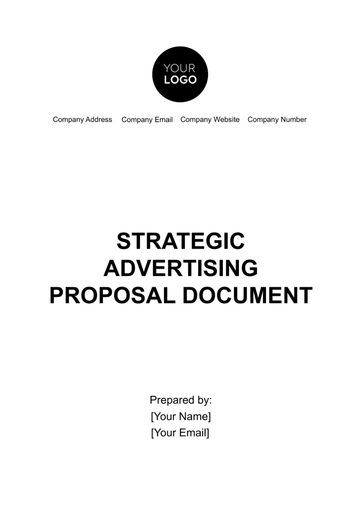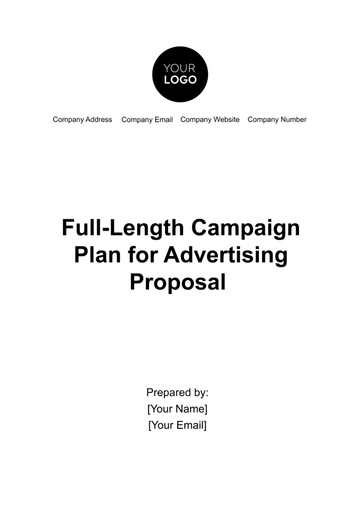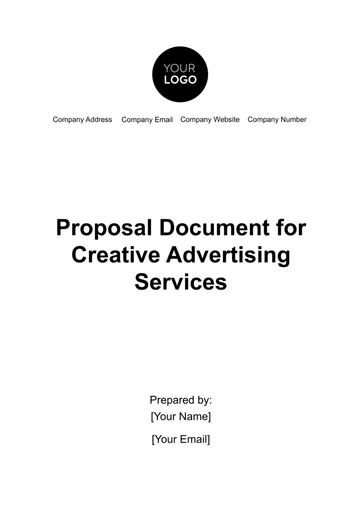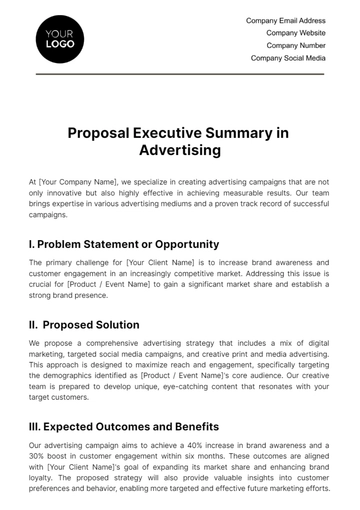Free Multi-Year Advertising Strategy Proposal

I. Executive Summary
This document presents our Multi-Year Advertising Strategy Proposal, outlining a plan to enhance brand visibility, engage target audiences, and drive business growth. This proposal outlines our plan to address market challenges, capitalize on opportunities, and solidify our position as a leader in the market.
II. SWOT Analysis
Strengths | Weaknesses |
Strong brand reputation | Limited presence in the market |
Innovative product offerings | Need for improved digital presence |
Opportunities | Threats |
Growing demand for [Product Name]. | Intense competition from competitors |
Need for improved digital presence | Economic uncertainties |
III. Objectives
Over the next [3] years, our advertising objectives are designed to align seamlessly with our broader business goals, ensuring a strategic and impactful approach to brand promotion and customer engagement.
1. Increase Brand Awareness by [3]%
Implement a targeted TV and online campaign, leveraging captivating visuals and emotionally resonant storytelling to leave a lasting impression on our target audience.
Launch a social media awareness campaign, encouraging user-generated content and participation.
2. Boost Sales by [20]%
Introduce a limited-time promotional offer tied to specific advertising channels, closely monitoring sales attribution to measure the campaign's impact.
Implement a retargeting strategy online, capitalizing on user interactions with our ads to drive conversions.
3. Enhanced Customer Engagement
Launch a customer loyalty program with exclusive benefits, promoted through both online and offline channels.
Initiate an interactive online campaign encouraging customer feedback and testimonials, fostering a sense of community around our brand.
IV. Target Audience
Our primary target audience comprises young adults and professionals. Through extensive market research, we've identified their behaviors, preferences, and pain points. Understanding these nuances enables us to tailor our campaigns for maximum resonance.
To further refine our targeting, we'll employ advanced data analytics, incorporating insights from past campaigns and customer interactions. Regular surveys and feedback mechanisms will ensure that our understanding of the target audience evolves with changing trends and preferences.
V. Competitive Analysis
SWOT Analysis
Strengths
Our in-depth product knowledge and commitment to innovation position us as leaders in [Product Name]. We leverage cutting-edge technology to deliver superior quality, setting us apart from competitors.
Weaknesses
While our product quality is exceptional, our competitors excel in the local market. Addressing this gap will be a focal point of our advertising strategy.
Opportunities
The growing trend presents a significant opportunity. By aligning our messaging with this trend, we can capture a larger market share.
Threats
Intense competition from [Competitor 1] and [Competitor 2] poses a threat. Our strategy includes proactive measures to counter their initiatives and solidify our market position.
VI. Key Messages
Our key messages revolve around our core brand values, emphasizing Quality, Innovation, and Customer-Centricity. These messages resonate with our target audience's aspirations and expectations.
To ensure consistency across all channels, a detailed messaging guide has been developed. This guide includes approved taglines, value propositions, and communication tones. Regular training sessions will be conducted to align our team members with these key messages.
VII. Media Planning
Channel Selection
TV: Leveraging prime-time slots for broad reach, with an emphasis on Popular Shows known to attract our target audience.
Online: Focused digital campaigns on platforms like Social Media and Online Publications, utilizing targeted advertising to reach specific demographics.
Radio: Engaging local audiences through targeted radio ads during peak commuting hours, aligning with our target audience's daily routines.
B. Budget Allocation
Channel | Amount |
TV | $10,000 |
Online | |
Radio |
VIII. Creative Strategy
Our creative strategy emphasizes visually striking elements, compelling taglines, and consistent branding. The visual elements will evoke emotions that resonate with our target audience, creating a memorable and impactful brand image.
To maintain consistency, a comprehensive style guide has been developed. This guide outlines approved color schemes, typography, and design principles. Regular creative reviews will ensure adherence to these guidelines across all advertising materials.
IX. Timeline
The advertising timeline is planned to coincide with Product Launches, Seasonal Trends, and Industry Events. This ensures that our campaigns remain relevant and capitalize on peak periods of consumer engagement. Regular check-ins and status updates will be conducted to monitor progress, with flexibility built in to accommodate unforeseen challenges or opportunities.
Start Date | End Date | Activity |
[Month Day, Year] | [Month Day, Year] | Product Launch |
[Month Day, Year] | ||
[Month Day, Year] |
X. Budgeting by Year
Year 1:
Channel | Amount | Allocation |
TV | $10,000 | 20% |
Online | ||
Radio |
Year 2:
Channel | Amount | Allocation |
TV | $15,000 | 25% |
Online | ||
Radio |
Year 3:
Channel | Amount | Allocation |
TV | $25,000 | 30% |
Online | ||
Radio |
XI. Metrics and Measurement
A. Key Performance Indicators (KPIs)
Brand Awareness:
a. Increase in brand mentions: Monitor and analyze brand mentions on social media platforms, emphasizing engagement and sentiment analysis.
b. Engagement Growth: Implement engaging content, interactive polls, and user-generated campaigns to foster community participation.
Sales:
a. Attributed Sales Increase: Implement unique promo codes, track online and offline sales data, and conduct surveys to understand the impact on purchasing decisions.
b. Conversion Rates: Optimize online channels based on user behavior, conduct A/B testing, and refine the online customer journey.
Customer Engagement:
a. Online Interaction: Monitor click-through rates, comments, and shares on online platforms, adjusting content strategies based on engagement data.
b. Customer Satisfaction Scores: Implement post-purchase surveys, analyze customer feedback, and address pain points proactively to enhance overall satisfaction.
B. Reporting Schedule
1. Monthly Reports: Detailed breakdown of KPIs for each campaign and channel. Analysis of social media metrics, website traffic, and sales data.
2. Quarterly Reviews: Comprehensive overview of campaign performance. Identification of trends, successes, and areas for improvement.
Annual Reports: Holistic assessment of the entire year's advertising strategy. Strategic insights and recommendations for the upcoming year.
XII. Risk Analysis
A. Identified Risks
Competitive Response: The potential for competitors to launch similar or more aggressive marketing campaigns.
a. Proactive Response: Establish a dedicated team to monitor competitor activities, leveraging advanced analytics tools. Regularly review and adjust marketing strategies to maintain a competitive edge.
Economic Downturn: Consumer spending may be adversely affected by economic downturns, impacting sales.
a. Proactive Response: Develop flexible promotional strategies that can be rapidly deployed to retain consumer interest and adapt pricing models to suit changing economic conditions.
B. Mitigation Strategies
Proactive Monitoring: Continuously track and analyze competitors' strategies using real-time market intelligence and digital monitoring tools. This information will guide strategic adjustments to stay ahead of market trends.
Flexible Budgeting: Implement a flexible budgeting approach that allows for the reallocation of resources in response to market changes. This ensures financial agility and effective use of funds.
C. Contingency Plans
Rapid Response Team: In the event of unexpected market challenges, a specialized contingency team will be mobilized to swiftly assess the situation. This team will have the authority and resources to make immediate decisions and implement necessary changes to the advertising and marketing strategies.
Scenario Planning: Regularly update and test various scenario plans to prepare for different potential risks, ensuring a prompt and effective response to various market conditions.
XIII. Review and Evaluation
A. Continuous Improvement: These meetings will be a cornerstone for ongoing evaluation, scheduled at systematic intervals. The primary objectives will include:
Performance Analysis: Assess the effectiveness of current campaigns using a range of metrics and KPIs. This evaluation will focus on both quantitative results and qualitative outcomes.
Incorporation of Learnings: Identify key insights and learnings from ongoing and past campaigns. These insights will be critical in refining and optimizing future marketing initiatives, ensuring a cycle of continuous improvement.
B. Stakeholder Feedback
Internal Team Insights: Regularly gather feedback from various internal teams, including marketing, sales, customer service, and product development. This multidisciplinary feedback will provide a holistic view of the campaign’s impact across the company.
Customer Feedback Mechanisms: Implement a robust system to collect and analyze customer feedback through surveys, social media interactions, and direct customer communications. This feedback is vital for understanding customer needs, preferences, and areas for improvement.
Strategic Adjustment Based on Feedback: Utilize the insights gained from both internal and external feedback to make informed adjustments to marketing strategies. This approach ensures that strategies remain aligned with both market demands and internal objectives.
XIV. Conclusion
This Multi-Year Advertising Strategy Proposal represents our unwavering commitment to innovation, brand excellence, and customer satisfaction. By aligning our advertising objectives with overarching business goals, we embark on a journey to elevate brand awareness, foster customer engagement, and drive sustainable growth. We look forward to the exciting opportunities and challenges that lie ahead, confident in our ability to create enduring impact.
- 100% Customizable, free editor
- Access 1 Million+ Templates, photo’s & graphics
- Download or share as a template
- Click and replace photos, graphics, text, backgrounds
- Resize, crop, AI write & more
- Access advanced editor
Unlock the power of strategic advertising with Template.net's Multi-Year Advertising Strategy Proposal Template. Seamlessly editable and fully customizable, this template equips you with the tools to craft compelling proposals tailored to your brand. Utilize our Ai Editor Tool to refine your strategies and captivate your audience with precision.
You may also like
- Business Proposal
- Research Proposal
- Proposal Request
- Project Proposal
- Grant Proposal
- Photography Proposal
- Job Proposal
- Budget Proposal
- Marketing Proposal
- Branding Proposal
- Advertising Proposal
- Sales Proposal
- Startup Proposal
- Event Proposal
- Creative Proposal
- Restaurant Proposal
- Blank Proposal
- One Page Proposal
- Proposal Report
- IT Proposal
- Non Profit Proposal
- Training Proposal
- Construction Proposal
- School Proposal
- Cleaning Proposal
- Contract Proposal
- HR Proposal
- Travel Agency Proposal
- Small Business Proposal
- Investment Proposal
- Bid Proposal
- Retail Business Proposal
- Sponsorship Proposal
- Academic Proposal
- Partnership Proposal
- Work Proposal
- Agency Proposal
- University Proposal
- Accounting Proposal
- Real Estate Proposal
- Hotel Proposal
- Product Proposal
- Advertising Agency Proposal
- Development Proposal
- Loan Proposal
- Website Proposal
- Nursing Home Proposal
- Financial Proposal
- Salon Proposal
- Freelancer Proposal
- Funding Proposal
- Work from Home Proposal
- Company Proposal
- Consulting Proposal
- Educational Proposal
- Construction Bid Proposal
- Interior Design Proposal
- New Product Proposal
- Sports Proposal
- Corporate Proposal
- Food Proposal
- Property Proposal
- Maintenance Proposal
- Purchase Proposal
- Rental Proposal
- Recruitment Proposal
- Social Media Proposal
- Travel Proposal
- Trip Proposal
- Software Proposal
- Conference Proposal
- Graphic Design Proposal
- Law Firm Proposal
- Medical Proposal
- Music Proposal
- Pricing Proposal
- SEO Proposal
- Strategy Proposal
- Technical Proposal
- Coaching Proposal
- Ecommerce Proposal
- Fundraising Proposal
- Landscaping Proposal
- Charity Proposal
- Contractor Proposal
- Exhibition Proposal
- Art Proposal
- Mobile Proposal
- Equipment Proposal
- Student Proposal
- Engineering Proposal
- Business Proposal





























